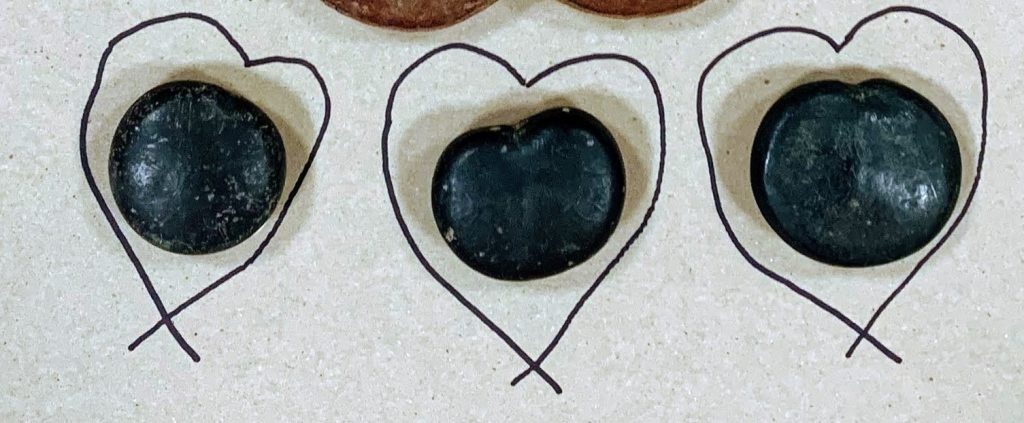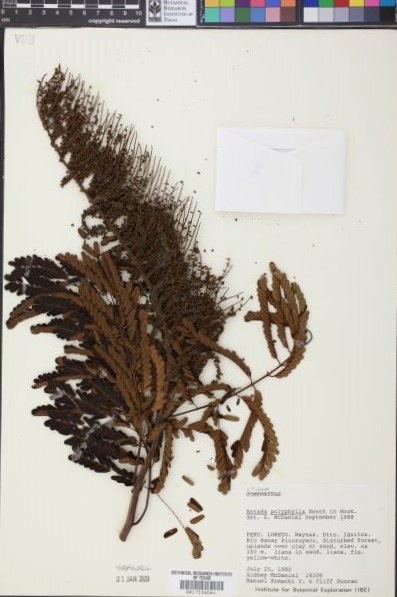The BRIT Philecology Herbarium is composed of a melting pot of several orphaned collections across the south and southeast. In addition to those large collections, we also receive specimens through active exchange programs with more than one hundred herbaria across the world. Each of our large collections – BRIT/SMU (Southern Methodist University), VDB (Vanderbilt), and NLU (University of Louisiana at Monroe) – complete one another by filling in geographical and taxonomic gaps of their holdings.

These heart-shaped seeds were found in a wood collection acquired from Houston Public Museum. The seeds come from plants in the genus Entada in the legume family (Fabaceae). These plants are typically woody vines, or lianas, that establish themselves along beaches and rivers. The seeds produced by Entada species are intended to be world drifters! The seeds are buoyant enough to float on the water and resilient enough to sail the seas for long periods of time. By looking at this group of plants, our puzzle piece collections present us with almost ten different species, some dating back 60 years, collected from just about every continent. With only 33 specimens total of Entada, we are still empowered with a treasure trove of data that can enable us to ask interesting questions about this fascinating group of sea beans.
When we use our collections data to place locality points on a map, we can compare this to other types of maps – like a map of the ocean’s currents! It’s easy to see a story unfold of Entada and how it spread across the globe using the ocean as a means of travel. Thanks to platforms like Symbiota, herbaria are able to upload collections data that are accessible for both researchers and the public. The possibilities are endless to discover something new and plan for the future of our planet’s biodiversity.


(1) Entada gigas : Our sea heart 🤍 and the longest legume in the world! The seedpods can grow up to 6 feet in length and hold 10-15 heart-shaped seeds. These seeds wash up on shores and are believed to be good luck. Specimen below deposited in NLU.

(2) Entada polyphylla : This species is only found in South America in riverine forests and thickets. The beans of E. polyphylla have been used by locals as a treatment for congestion. Specimen below deposited in VDB.

(3) Entada rheedii :This species is also known as the “African dream herb”. The seed has also been known to enhance dreams for ritual purposes in several cultures across the world where it is found. The seed is not quite as heart-shaped as E. gigas, but it has been used as charms and jewelry. Specimen below deposited in BRIT.

(4) Entada phaseoloides : This species is also called the St. Thomas Bean! The juice of the stem has been used to treat joint and muscle pains, and the seed is edible once it has been soaked and roasted. BRIT’s very own Research team has recently explored the Philippine islands! You can read more here. Specimen below deposited in BRIT.

Sources:
*Armstrong, W.P. 2004. “The Remarkable Sea Heart.” Wayne’s Word: An On-Line Textbook of Natural History.
*Buckman, R. “Sea Bean Facts.” Sea Heart. Sea Heart Inc.
*Fern, K. 2019. “Useful Tropical Plants.” Tropical Plants Database. 13 Jun 2019.
*Merchant, The Dream. 2020. “African Dream Herb (Entada rheedii).” The Dream Merchant’s Shop. DreamMerchant.shop. 25 Jan 2020.
*Quattrocchi, U. 2012. CRC World Dictionary of Medicinal and Poisonous Plants: Common names, scientific names, eponyms, synonyms, and etymology. CRC Press.
*Science Education Resource Center. 2019. “4A: Tracing Pathways.” Earth System Science. 7 Feb 2019.
This post is part of our “Cabinet Curiosities” series that explores significant items from the Herbarium collection. Posts are written by staff, volunteers, and interns. Read more from the series here.







